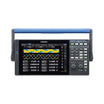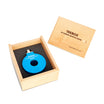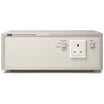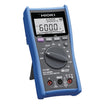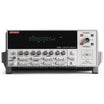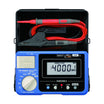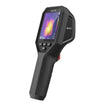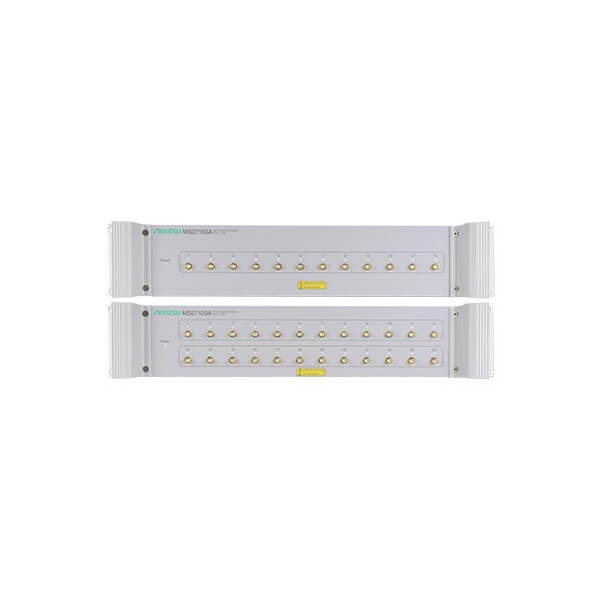
Anritsu MS27103A Remote Spectrum Monitor
Use our chat for personal support or contact us via +45 31 33 18 19 or salg@GOmeasure.dk
- 9 kHz to 6 GHz
- 12 (optionally 24) RF IN ports for use with multiple antennas
- Sweep speed up to 24 GHz/s
- Integrated web server to view, control and conduct measurements via web browser
- Watchdog timer to insure long-term stability for remotely deployed monitors
- Low spur levels for accurate signal discovery
- 20 MHz instantaneous FFT bandwidth
Discover the possibilities
More information
Description
Anritsu MS27103A Remote Spectrum Monitor
Cellular network operators have invested billions of dollars in purchasing rights to use frequency spectrum around the world. This spectrum is necessary to deliver the high data bandwidth demanded by smartphone users to view emails, web pages and stream audio and video while mobile. In order to maintain a high level of network performance, operators need to continually monitor their spectrum to identify and locate sources of interference. Interference can come from illegal transmitters and from unintended sources such as intermodulation products. All will reduce the networks data capacity, which results in a reduced user experience. Operators can act quickly to protect their investment and maintain data capacity.The MS27103A remote spectrum monitor is designed to identify and locate interfering signals. This serves to optimize the user experience, a key goal for network operators. This translates into customer loyalty, reduced customer churn and superior brand.
Additionally, DAS systems are being deployed extensively around the world to provide high data capacity in dense user environments. These include transport hubs, sports stadiums and shopping malls. From a single equipment room, multiple feeds pan out to a distributed array of antennas. Monitoring for interference signals on each of these RF feeds is essential to maintain capacity for the DAS system. The MS27103A is the perfect monitoring solution for DAS systems to help maintain overall system performance.
The MS27103A is housed in a rack-mountable enclosure with 12 (or optionally) 24 RF Inputs. An electronic switch is used to address each port. The MS27103A is a full featured platform for monitoring and recording signals at user specified frequencies.
Capable of sweep rates up to 24 GHz/s, the MS27103A allows for the capture of many types of signals. This includes periodic or transient transmissions as well as short “bursty” signals. The 20 MHz instantaneous FFT bandwidth available on the MS27103A monitor provides the ability for wideband real-time captures of signal activity for subsequent post-processing. IQ captures can be recorded both in block mode or streamed. A “save on event” feature is also provided to capture spectrum measurements only when certain user-settable thresholds are violated. This saves memory space since only signals of interest are captured and recorded.
Communicating with remote spectrum monitors
Several ways of communicating with the MS27103A can be utilized. These methods are highlighted below.
1. Integrated Web Server
An integrated web server is embedded into the MS27102A. Using an internet browser (Chrome and FireFox are supported), a user from anywhere in the world can log in to the spectrum monitor and control any of its features. This includes such parameters as frequency setting, RBW/VBW control, reference level configuration and many other settings relevant to the user’s spectrum monitoring application. At the same time, trace data, spectrograms and other measurements can be viewed inside the browser window. A key advantage of the web server is that it is operating system platform agnostic. Any electronic device capable of rendering a browser will work with the web server. PCs/laptops, tablets or even smart phones can be used to view spectrum and adjust remote instrument settings. Each monitor also features Gbit Ethernet, allowing fast transfers of measurement data and control information.
2. SCPI Programming
Users can also write their own monitoring program using available SCPI commands. Anritsu provides a user manual listing each SCPI command, a description of the commands and the correct syntax required for each command. Additionally, each individual pair of IQ data output by the monitors is time-stamped using high precision GPS signals. This enables the use of IQ data for Time Distance of Arrival (TDOA) applications for geo-locating signal positions. IQ data time stamp resolution is less than 9 nSec for precise signal location calculations.
3. Vision™ Application Software
Vision™ software is also available as an option. Vision works with the monitoring hardware to automate the process of collecting measurement data, providing useful information about network heath and use of the spectrum. Vision is composed of two components responsible for monitoring and locating interference signals.
- Vision Monitor (option 400)
- Vision Locate (option 401)
Vision Monitor automatically records spectrum data, maintains a searchable spectrum history database, enables alarm functions for unusual signal activity, automatically sends email alerts and provides a set of tools for managing the spectrum monitoring system.
Vision Locate provides the capability to geo-locate interference or illegal/unlicensed signals. To properly locate signal positions, three or more monitors must be used. More information about the Vision products can be reviewed on the Anritsu website.
Key Features
- 9 kHz to 6 GHz
- Sweep speed up to 24 GHz/s
- Integrated web server to view, control and conduct measurements via a web browser (both Chrome and FireFox supported)
- Remote firmware update capable
- Watchdog timer to insure long-term stability for remotely deployed monitors
- Linux operating system
- Low spurious signals for accurate signal discovery
- 20 MHz instantaneous FFT bandwidth
- Low power consumption < 11 watts (input voltage 11 to 24 VDC)
- Integrated GPS receiver for monitoring location and time synchronization applications
- Gigabit Ethernet available for high speed transmissions
- Interference analysis: spectrogram and signal strength
- Dynamic range: > 106 dB normalized to 1 Hz BW
- DANL: < -150 dBm referenced to 1 Hz RBW, preamp on
- Phase noise: -99 dBc/Hz @ 10 kHz offset at 1 GHz
- IQ block mode and streaming with time stamping for TDOA applications
- Vision software optional for automated spectrum measurements, setting alarms and geo-locating signal sources
MS27103A for Spectrum Assurance
The MS27103A is a multi-port RF In monitoring platform employed in systems requiring multiple antennas to cover a large frequency range. This monitor is often used with cellular infrastructure equipment with multiple sectors and multiple frequencies per sector. Billions of dollars are typically spent by network operators on spectrum auction acquisitions. To protect that investment, it is imperative that cellular providers provide quality service to their customers. Interference from a variety of sources leads to dropped calls, slow data rates and poor network performance. The MS27103A can monitor receive signals at the BTS, facilitating the identification and removal of interference. Patterns of unwanted signal activity can also be examined, providing an efficient way to characterize and locate the source of the interference problem.
For more information: Anritsu
Specifications
Documents
Anritsu MS27103A Remote Spectrum Monitor
Datasheet:
Anritsu MA27103A DatasheetProduct Brochure:
Anritsu MS27103A Product BrochureOptions
Anritsu MS27103A Remote Spectrum Monitor
Hardware Options
| Option | Description |
| MS27103A-0706 | 9 kHz – 6 GHz Spectrum Monitor |
| MS27103A-0424 | Expands Input Port to 24 SMA(f) |
| MS27103A-0110 | 110/220 VAC Power Supply |
| MS27103A-0412 | Two Ethernet Ports |
Vision Options
| Option | Description |
| MS27103A-0400 | Vision Monitor Enabled |
| MS27103A-0401 | Vision Locate Enabled (requires option 400) |
| MS27103A-0407 | High-Speed Port Scanner |
| MS27103A-0486 | Coverage Mapping (requires option 407) |
Video
Anritsu MS27103A Remote Spectrum Monitor
Cellular network operators have invested billions of dollars in purchasing rights to use frequency spectrum around the world. This spectrum is necessary to deliver the high data bandwidth demanded by smartphone users to view emails, web pages and stream audio and video while mobile. In order to maintain a high level of network performance, operators need to continually monitor their spectrum to identify and locate sources of interference. Interference can come from illegal transmitters and from unintended sources such as intermodulation products. All will reduce the networks data capacity, which results in a reduced user experience. Operators can act quickly to protect their investment and maintain data capacity.The MS27103A remote spectrum monitor is designed to identify and locate interfering signals. This serves to optimize the user experience, a key goal for network operators. This translates into customer loyalty, reduced customer churn and superior brand.
Additionally, DAS systems are being deployed extensively around the world to provide high data capacity in dense user environments. These include transport hubs, sports stadiums and shopping malls. From a single equipment room, multiple feeds pan out to a distributed array of antennas. Monitoring for interference signals on each of these RF feeds is essential to maintain capacity for the DAS system. The MS27103A is the perfect monitoring solution for DAS systems to help maintain overall system performance.
The MS27103A is housed in a rack-mountable enclosure with 12 (or optionally) 24 RF Inputs. An electronic switch is used to address each port. The MS27103A is a full featured platform for monitoring and recording signals at user specified frequencies.
Capable of sweep rates up to 24 GHz/s, the MS27103A allows for the capture of many types of signals. This includes periodic or transient transmissions as well as short “bursty” signals. The 20 MHz instantaneous FFT bandwidth available on the MS27103A monitor provides the ability for wideband real-time captures of signal activity for subsequent post-processing. IQ captures can be recorded both in block mode or streamed. A “save on event” feature is also provided to capture spectrum measurements only when certain user-settable thresholds are violated. This saves memory space since only signals of interest are captured and recorded.
Communicating with remote spectrum monitors
Several ways of communicating with the MS27103A can be utilized. These methods are highlighted below.
1. Integrated Web Server
An integrated web server is embedded into the MS27102A. Using an internet browser (Chrome and FireFox are supported), a user from anywhere in the world can log in to the spectrum monitor and control any of its features. This includes such parameters as frequency setting, RBW/VBW control, reference level configuration and many other settings relevant to the user’s spectrum monitoring application. At the same time, trace data, spectrograms and other measurements can be viewed inside the browser window. A key advantage of the web server is that it is operating system platform agnostic. Any electronic device capable of rendering a browser will work with the web server. PCs/laptops, tablets or even smart phones can be used to view spectrum and adjust remote instrument settings. Each monitor also features Gbit Ethernet, allowing fast transfers of measurement data and control information.
2. SCPI Programming
Users can also write their own monitoring program using available SCPI commands. Anritsu provides a user manual listing each SCPI command, a description of the commands and the correct syntax required for each command. Additionally, each individual pair of IQ data output by the monitors is time-stamped using high precision GPS signals. This enables the use of IQ data for Time Distance of Arrival (TDOA) applications for geo-locating signal positions. IQ data time stamp resolution is less than 9 nSec for precise signal location calculations.
3. Vision™ Application Software
Vision™ software is also available as an option. Vision works with the monitoring hardware to automate the process of collecting measurement data, providing useful information about network heath and use of the spectrum. Vision is composed of two components responsible for monitoring and locating interference signals.
- Vision Monitor (option 400)
- Vision Locate (option 401)
Vision Monitor automatically records spectrum data, maintains a searchable spectrum history database, enables alarm functions for unusual signal activity, automatically sends email alerts and provides a set of tools for managing the spectrum monitoring system.
Vision Locate provides the capability to geo-locate interference or illegal/unlicensed signals. To properly locate signal positions, three or more monitors must be used. More information about the Vision products can be reviewed on the Anritsu website.
Key Features
- 9 kHz to 6 GHz
- Sweep speed up to 24 GHz/s
- Integrated web server to view, control and conduct measurements via a web browser (both Chrome and FireFox supported)
- Remote firmware update capable
- Watchdog timer to insure long-term stability for remotely deployed monitors
- Linux operating system
- Low spurious signals for accurate signal discovery
- 20 MHz instantaneous FFT bandwidth
- Low power consumption < 11 watts (input voltage 11 to 24 VDC)
- Integrated GPS receiver for monitoring location and time synchronization applications
- Gigabit Ethernet available for high speed transmissions
- Interference analysis: spectrogram and signal strength
- Dynamic range: > 106 dB normalized to 1 Hz BW
- DANL: < -150 dBm referenced to 1 Hz RBW, preamp on
- Phase noise: -99 dBc/Hz @ 10 kHz offset at 1 GHz
- IQ block mode and streaming with time stamping for TDOA applications
- Vision software optional for automated spectrum measurements, setting alarms and geo-locating signal sources
MS27103A for Spectrum Assurance
The MS27103A is a multi-port RF In monitoring platform employed in systems requiring multiple antennas to cover a large frequency range. This monitor is often used with cellular infrastructure equipment with multiple sectors and multiple frequencies per sector. Billions of dollars are typically spent by network operators on spectrum auction acquisitions. To protect that investment, it is imperative that cellular providers provide quality service to their customers. Interference from a variety of sources leads to dropped calls, slow data rates and poor network performance. The MS27103A can monitor receive signals at the BTS, facilitating the identification and removal of interference. Patterns of unwanted signal activity can also be examined, providing an efficient way to characterize and locate the source of the interference problem.
For more information: Anritsu
Anritsu MS27103A Remote Spectrum Monitor
Datasheet:
Anritsu MA27103A DatasheetProduct Brochure:
Anritsu MS27103A Product BrochureAnritsu MS27103A Remote Spectrum Monitor
Hardware Options
| Option | Description |
| MS27103A-0706 | 9 kHz – 6 GHz Spectrum Monitor |
| MS27103A-0424 | Expands Input Port to 24 SMA(f) |
| MS27103A-0110 | 110/220 VAC Power Supply |
| MS27103A-0412 | Two Ethernet Ports |
Vision Options
| Option | Description |
| MS27103A-0400 | Vision Monitor Enabled |
| MS27103A-0401 | Vision Locate Enabled (requires option 400) |
| MS27103A-0407 | High-Speed Port Scanner |
| MS27103A-0486 | Coverage Mapping (requires option 407) |


